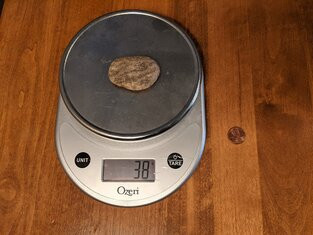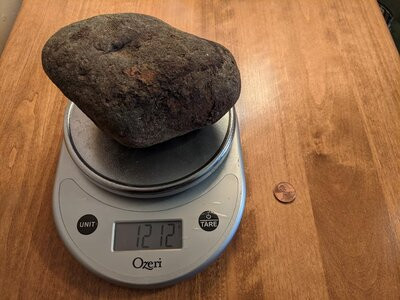How Much Does A Small Rock Weigh? The answer isn’t as simple as it seems, but at rockscapes.net, we’re here to break it down for you. Understanding the weight of rocks is crucial for various landscaping projects, from designing rock gardens to building sturdy retaining walls. Whether you’re a homeowner, landscape designer, or DIY enthusiast, knowing the approximate weight of different rock sizes and types will help you plan and execute your projects efficiently. We’ll explore the factors influencing rock weight, provide weight estimations for various rock sizes and types, and offer practical methods for calculating the weight of any rock you encounter.
1. Rock Weight By Size: A Practical Guide
Trying to estimate the weight of a rock based on its size? We’ve done the groundwork for you. Below is a table featuring common rock sizes, their approximate diameters, and corresponding weights in both imperial and metric units. Remember, actual weights can vary based on the rock’s density, but this chart provides a reliable estimate for your planning needs.
| Rock Size | Diameter (in) | Weight (Imperial) | Weight (Metric) |
|---|---|---|---|
| Pebble | 0.5 | 0.035 ounces | 1 g |
| Landscaping Rock | 1.25 | 1.41 ounces | 40 g |
| Skipping Stone | 1.6 | 1.41 ounces | 40 g |
| Cobble | 4.5 | 2.6 pounds | 1.2 kg |
| Basketball Sized | 9.5 | 42 pounds | 19 kg |
| Yoga Ball Sized | ~26 | ~920 pounds | ~418 kg |
| Car Sized | ~10 ft | ~86,500 pounds | ~39,271 kg |
| Bag of Landscaping Rocks | — | 50 pounds | 22.7 kg |
| Pallet of Landscaping Rocks (50 bags) | — | 2,500 pounds | 1,136 kg |
1.1. Pebble: The Tiny Titan
The average pebble weighs approximately 1 gram (0.035 ounces). Individual pebble weights can range from 0.1 grams to 3 grams (0.0035 ounces to 0.106 ounces). These small stones are perfect for adding texture and detail to your garden beds or creating decorative mosaics.
 Pebbles next to a penny for scale, illustrating their individual weights
Pebbles next to a penny for scale, illustrating their individual weights
 A single pebble on a scale, showing a weight of approximately 1 gram
A single pebble on a scale, showing a weight of approximately 1 gram
1.2. Landscaping Rocks: Versatile Decor
A typical landscaping rock weighs around 40 grams, or 1.4 ounces. These rocks are commonly used in gardens to add visual appeal, suppress weeds, and prevent soil erosion. Their manageable size makes them ideal for various DIY projects.
 Landscaping rock compared to a penny, emphasizing its size relative to the coin
Landscaping rock compared to a penny, emphasizing its size relative to the coin
 Landscaping rock on a scale, confirming its approximate weight of 40 grams
Landscaping rock on a scale, confirming its approximate weight of 40 grams
1.3. Skipping Stone: A Throwback to Childhood
An average-sized skipping stone typically weighs about 40 grams or 1.4 ounces. These flat, smooth stones are perfect for enjoying a classic outdoor activity by the water. Their size and weight are ideal for throwing and skipping across the water’s surface.
 A standard skipping stone on a scale, registering a weight of about 40 grams
A standard skipping stone on a scale, registering a weight of about 40 grams
1.4. Cobble: Pathway Essentials
Cobblestones, often used in pathways and decorative landscaping, weigh approximately 2.6 pounds or 1.2 kg. Their substantial size makes them durable and long-lasting, perfect for creating rustic and charming outdoor spaces.
 Cobblestone on a scale indicating its weight as 1212 grams
Cobblestone on a scale indicating its weight as 1212 grams
1.5. Basketball Sized Rock: A Hefty Addition
A rock about the size of a basketball weighs roughly 42 pounds, or 19 kg. These larger rocks can serve as focal points in your landscape design, adding drama and visual interest to your garden.
 Basketball-sized rock on a scale showing its weight at 42 pounds
Basketball-sized rock on a scale showing its weight at 42 pounds
1.6. Yoga Ball Sized Rock: A Landscape Statement
Approximating the weight of a rock this size requires calculation. A yoga ball-sized rock, roughly 26 inches in diameter, weighs around 920 pounds, or 418 kg, assuming an average rock density. These boulders are ideal for creating impressive, natural-looking features in expansive landscapes.
1.7. Car Sized Rock: Monumental Proportions
Estimating the weight of a car-sized rock involves significant approximations. A boulder roughly the size of a car, with a diameter of about 10 feet, weighs approximately 86,500 pounds, or 39,271 kg, based on average rock density.
1.8. Bags of Landscaping Rocks: Convenient Quantities
A bag of landscaping rocks typically weighs 50 pounds. These bags are easy to handle for smaller projects and provide a convenient way to transport rocks to your garden or landscape site.
A pallet containing 50 bags of landscaping rocks weighs approximately 2,500 pounds. Ensure your vehicle can handle this weight if you’re picking up a pallet from a store.
2. Rock Weight by Type: Exploring Density
Different types of rocks have varying densities, which directly impact their weight. The table below lists common rock types and their approximate weights per cubic foot. This information is crucial for accurately estimating the weight of materials for construction and landscaping projects.
| Rock Type | Size | Density (g/cm3) | Weight (lbs) | Weight (kg) |
|---|---|---|---|---|
| Sandstone | 1 ft3 | 2.30 | 143.6 | 65.2 |
| Limestone | 1 ft3 | 2.70 | 168.6 | 76.5 |
| Shale | 1 ft3 | 2.35 | 146.7 | 66.6 |
| Dolomite | 1 ft3 | 2.60 | 162.6 | 73.8 |
| Granite | 1 ft3 | 2.63 | 164.1 | 74.5 |
| Marble | 1 ft3 | 2.71 | 169.1 | 76.8 |
| Basalt | 1 ft3 | 2.90 | 181.0 | 82.2 |
| Quartzite | 1 ft3 | 2.65 | 165.4 | 75.1 |
| Gabbro | 1 ft3 | 2.98 | 186.0 | 84.4 |
Weight of 1 Cubic Foot of Rock By Type (Densities Source)
On average, a cubic foot of rock weighs 165.2 pounds, with variations ranging from 143.6 to 186.0 pounds depending on the specific rock type. Unusual densities can result in weights outside this range.
3. Weights of Famous Rocks & Lifting Stones: A Test of Strength
Did you know that there are famous rocks known for their weight and the challenge they present to those who attempt to lift them? These lifting stones, often found in Scotland and Iceland, attract enthusiasts from around the world.
During a trip to Scotland, I sought out a lifting stone and successfully lifted the Puterach stone, which weighs 230 pounds!
 The author after successfully lifting the Puterach stone, weighing 230 pounds
The author after successfully lifting the Puterach stone, weighing 230 pounds
Here are some famous lifting stones and their weights:
| Stone Name | Weight (lbs) | Weight (kg) | Location |
|---|---|---|---|
| Dinnie Stones | 733 | 332 | Potarch, Scotland |
| Inver Stone | 260 | 118 | Inver, Scotland |
| Barevan Stone | 231 | 105 | Cawdor, Scotland |
| Newtonmore Stone | 240 | 109 | Newtonmore, Scotland |
| Dalwhinnie Stone | 224 | 102 | Dalwhinnie, Scotland |
| Fianna Stone | 300 | 136 | Glen Lyon, Scotland |
| Chieftain’s Stone | 250 | 113 | Castle Menzies, Scotland |
| Ardvorlich Stone | 334 | 152 | Ardvorlich, Scotland |
| Puterach Stone | 230 | 105 | Glen Balquidder, Scotland |
| Dripping Cave Stone | 286 | 130 | Cromarty, Scotland |
| Húsafell Stone | 409 | 186 | Húsafell, Iceland |
| Leggstein | 484 | 220 | Heydalur, Iceland |
| Judas Stone | 280 | 127 | Látrabjarg, Iceland |
Weights and Locations of Famous Lifting Stones
4. How To Calculate & Approximate The Weight of Rocks: A Step-by-Step Guide
If the previous measurements and tables don’t meet your needs, follow these instructions to calculate the weight of any rock. With a few simple measurements, you can accurately estimate the weight of your rock.
The most accurate way to determine a rock’s weight is to use a scale. However, when a scale isn’t available or the rock is too large, these steps can help.
The weight of any rock depends on its density and volume. Measuring or approximating these two values will allow you to estimate its weight accurately.
- Determine the rock type and density
- Measure the rock’s dimensions
- Calculate the weight of the rock
4.1. Determine Rock Type and Density
The first step in calculating a rock’s weight is determining its density. Geologists have extensively studied and documented the physical properties of various rocks, including their densities.
If you know the rock type, consult a table that lists densities for different rock types. If the rock type is unknown, use an average density of 2.7 g/cm3 for an estimate. According to research from Arizona State University’s School of Earth and Space Exploration, the density of rocks can provide insights into their formation and composition.
4.2. Measure the Rock’s Dimensions
Next, measure the rock’s dimensions to calculate its volume. The specific measurements and formulas depend on the rock’s shape. For consistency with density measurements (typically in g/cm3), measure in centimeters.
If the rock is roughly spherical, measure its circumference. For oblong or irregular shapes, measure a representative cross-section. Use the formula V=C3/(6π2).
If the rock is rectangular or cube-shaped, measure its height, width, and length and multiply them together. Use the formula V=h*w*l.
If you can’t directly measure the rock, estimate its dimensions visually. Use the same formulas to calculate its approximate volume.
4.3. Calculate the Weight of the Rock
With the density and volume measurements, calculate the weight using the formula:
Weight = Density * Volume
If the measurements were in cubic centimeters and grams, the result will be in grams. To convert grams to pounds, multiply the result by 0.0022.
5. Frequently Asked Questions (FAQs)
5.1. How big is a 1 ton rock?
Assuming an average weight of 165 pounds per cubic foot, a 1-ton rock has a volume of 12.1 cubic feet, a diameter of 2.85 feet, and a circumference of 9 feet.
5.2. Why are rocks so heavy?
Rocks are heavy due to their high density compared to other common materials. With an average density of 2.7 g/cm3, they are much denser than wood (~0.6 g/cm3) or water (1 g/cm3). According to the Department of Earth Sciences at the University of Arizona, rocks are dense because they consist of tightly packed, relatively heavy minerals.
5.3. How much does a 5-gallon bucket of rocks weigh?
A 5-gallon bucket of rocks weighs about 67 pounds.
5.4. How much does Dwayne ‘The Rock’ Johnson weigh?
Dwayne “The Rock” Johnson weighs 262 pounds.
5.5. What is the best type of rock for landscaping?
The best type of rock for landscaping depends on your specific needs and aesthetic preferences. Granite is durable and versatile, while limestone offers a softer, more natural look. Slate is excellent for pathways and patios due to its flat, even surface.
5.6. How do I calculate the amount of rock I need for my landscaping project?
To calculate the amount of rock needed, determine the area you want to cover, the desired depth of the rock layer, and then use a volume calculator. Most landscaping suppliers can help you estimate the quantity needed based on these measurements.
5.7. Where can I find reliable information on rock types and their properties?
Reliable information on rock types and their properties can be found at university geology departments, government geological surveys, and reputable online resources like rockscapes.net.
5.8. How does moisture affect the weight of rocks?
Moisture can significantly increase the weight of rocks, especially porous types like sandstone. Wet rocks can be considerably heavier than dry rocks, which should be considered when transporting and handling them.
5.9. Are there any safety precautions to consider when handling heavy rocks?
Yes, always wear appropriate safety gear, including gloves and sturdy shoes, when handling heavy rocks. Use proper lifting techniques, and consider using equipment like dollies or wheelbarrows for moving large stones to avoid injury.
5.10. What are the most common uses for small rocks in landscaping?
Small rocks are commonly used in landscaping for creating rock gardens, pathways, decorative ground cover, and drainage solutions. They add texture, visual interest, and functionality to outdoor spaces.
Choosing the right rocks for your landscaping project requires careful consideration of size, type, and weight. At rockscapes.net, we offer a comprehensive selection of rocks to meet all your landscaping needs. From pebbles to boulders, we provide detailed information and expert advice to help you create the perfect outdoor space.
Call to Action
Ready to transform your landscape with the beauty and durability of natural stone? Visit rockscapes.net today to explore our wide selection of rocks, get inspired by stunning design ideas, and receive expert advice from our experienced team. Whether you’re creating a serene rock garden, a functional retaining wall, or a captivating water feature, we have the perfect rocks to bring your vision to life. Contact us at +1 (480) 965-9011 or visit our location at 1151 S Forest Ave, Tempe, AZ 85281, United States. Let rockscapes.net be your partner in creating breathtaking and enduring landscapes.
